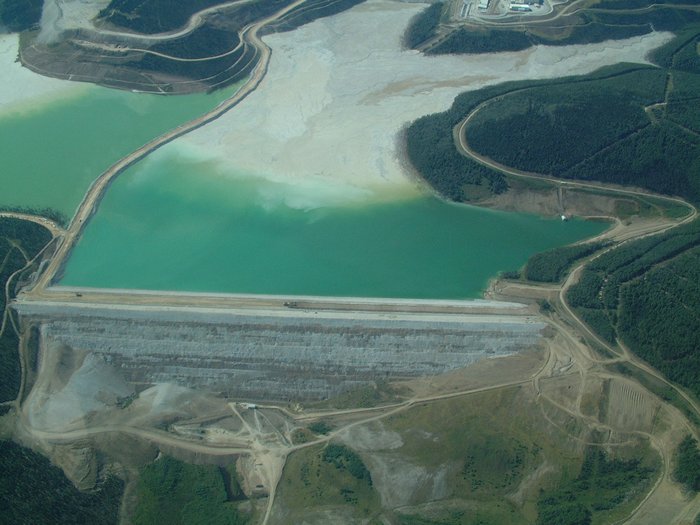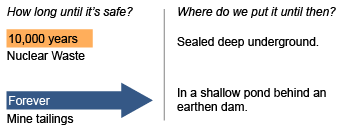
Perpetual waste storage
Toxic waste is an inevitable byproduct of many industries, from mines to power plants, nuclear reactors to municipal landfills. Therefore, we construct facilities to contain or treat these toxic byproducts. In many cases the mandate of these facilities is simple: store hazardous waste forever , or “in perpetuity.” This raises some very important - and sometimes poorly addressed concerns.
“Forever,” in the context of waste management does not literally mean “forever”. It is highly unlikely we’ll sequester any kind of waste until the proverbial “end of the universe”. It simply means that there is no point where it’s tolerable if management stops. So it boils down to, “Can we maintain these facilities long enough that any failure will not matter?” From the perspective of a given individual or company, maintenance long enough that that individual or company is not harmed by failure is relatively doable. Few individuals or companies survive for over a century. However, by leaving behind facilities requiring indefinite maintenance, we are imposing a dangerous burden on all future generations.

What is being stored?
Perhaps the most well-known perpetual maintenance plans are for municipal landfills, storing some plastics that can take millions of years to degrade. Leaching of toxins from these landfills could pose a significant chronic problem for surrounding areas. Other wastes have the potential to cause a more immediate catastrophe. Nuclear waste is the classic example of this kind of disposal problem - highly radioactive waste that takes tens of thousands of years to degrade.
While buried plastics and nuclear waste present significant potential future problems, they are outdone by the potential impacts of the perpetual storage of CO2, coal combustion wastes, and acid-generating mine tailings. The storage of these wastes must occur on immense scales, often with tightly constrained budgets, and as a result both the probability and impact of chronic leaks or catastrophic breaches is high.

This tailings impoundment dam at the Fort Knox gold mine in Alaska is a common method of storing mining waste forever.
 — 
<a class="figure-caption__link" href="/photos/typical-mine-tailings-dam/">Get Photo</a></figcaption></figure> Engineering “forever”
Engineering for perpetual storage is a field that is less than a century old, so no perpetual structures have existed for only a miniscule fraction of their engineered lifespan - often 10,000 years. Human engineering has not kept technological pace with our hazardous waste storage needs. All materials weather with time - metals corrode, cement degrades, and foundations shift. To compensate for this, many perpetuity plans call for active maintenance. However, there are dozens of examples of failed waste storage facilities that have occurred just within the last 50 years.
Any waste facility designed to last in perpetuity will have to face a bewildering array of natural stresses over the long term. These stresses could include erosion and weathering, earthquakes, changing climate, volcanic eruptions, lightening strikes, growing and shrinking glaciers, sea level changes, and even meteorite impacts. The chance of any certain event occurring at a particular facility within a given year is quite low. But given thousands of years, failure by some cause is nearly inevitable.
A storage facility must also be operated and maintained by future societies with unknown language, education, and financial/social organization. This is especially problematic for sites requiring active mechanical operations (such as water treatment), or active security. Future humans may vandalize or accidentally uncover sites, not realizing the consequences. Also, structures containing dangerous substances make potential military or terror targets.
Financial planning “forever”
Some long-term projects such as nuclear waste disposal are paid for by governments. Governments are assumed to always exist and be solvent, though history shows few last more than a few centuries. Other private projects are covered by a “closure bond”. In the case of mine tailings, for example, interest on the principal of this bond is supposed to cover the “in perpetuity” costs of a waste management project. However, it is impossible to realistically determine an appropriate bond size given the uncertainties of interest rates hundreds of years in the future.
An analysis of reclamation bond size for mines in Alaska has concluded that existing bonds are far too small to meet the liability of existing mines, not counting treatment in perpetuity. Elsewhere, this has led to costly government-funded cleanup efforts even over relatively short (decades) time frames. A recent example is that of the Zortman-Landusky mine in Montana. This mine was operated by a company called Pegasus which had a very poor environmental track record during the life of the mine. When the mine closed in 1998, Pegasus paid huge bonuses to its board, declared bankruptcy and rolled over its profitable assets into a new company. Meanwhile the state of Montana and the Bureau of Land Management have been paying the reclamation costs for the mine since the closure bond was over $33 million shy of reclamation costs. This mine will now require perpetual water treatment, paid for by Montana taxpayers for generations to come.
Historically, all economic systems have failed within centuries, so presumably the financial principal on a closure bond won’t last forever. Unforeseen political changes may lead to re-allocating of money, or the funds may disappear with the bondholder. When the money to prevent failure of perpetuity structures is gone, local populations or governments will have to pay or endure failure of the facility.
Alternatives to perpetuity
Instead of storing waste forever, industrial pollutant producers might be required to treat, recycle, dilute, or neutralize their waste within a defined time. These solutions are sometimes far more expensive than storage for the industrial producer of the waste, because they require that all the costs be borne by the polluter up front, instead of being spread over future generations. It may be that decreased consumption or expensive recycling of certain resources is both environmentally and economically more advantageous over the long term than continuing production of the hazardous wastes. Perpetual waste storage is an excellent example of an “externality”, a cost of some kind that is not paid by the buyer or seller of a commodity (see our article on “True Cost”).
If the long-term costs of producing waste were incorporated into the price of goods produced, this would greatly increase the motivation and cost-effectiveness of recycling materials instead of disposing of them. Policy could recognize the impossibility of perpetual storage, and require that companies define some timeframe in which their facility will be completely decommissioned, even if that timeframe is allowed to be long. Because our current system allows companies to promise the impossible, there is no motivation to solve the technical problems posed by waste handling.
Examples of attempted perpetual engineering solutions
Nuclear Waste
(Disposal problem timeframe: tens of thousands of years or more)
Nuclear waste is both extremely toxic and very long lasting. Most nuclear waste takes at least 10,000 years to decrease in radioactivity to the point where it will have minimal impact on the environment, and some materials may be hazardous for millions of years. Nuclear waste storage in tectonically stable, dry, deep environments has been explored in the US and elsewhere. The consequences of perpetual nuclear waste storage have been considered in detail, but no real solution has been developed:
“Active controls cannot be guaranteed in perpetuity because there is no guarantee that the necessary societal infrastructure can be maintained in perpetuity. Therefore, for the types of radioactive wastes considered here – wastes that remain hazardous for thousands of years – perpetual storage is not considered to be either feasible or acceptable.”
(From a paper published by International Atomic Energy Association (IAEA) in 2003)
Carbon Capture and Sequestration
(Disposal problem timeframe:1000+ years to mitigate climate change)
Carbon capture and sequestration (CCS) refers to the idea of collecting and storing carbon dioxide in order to mitigate the effects of climate change and ocean acidification. Possible storage sites include deep ocean trenches, saltwater aquifers, and geologic formations (including tapped-out oil and gas fields). In order to have a significant effect on climate, billons of tons of CO2 would need to be stored in this manner. Besides its renewed climate change impact, catastrophic escape of CO2 from a storage facility would displace air at the release site and cause asphyxiation. For example, mass asphyxiation of thousands of humans and animals has occurred in the past during natural releases from CO2 deposits at Lake Nyos.
Coal Wastes and Underground Coal Gasification
(Disposal problem timeframe: forever)
The combustion of coal creates a large number of toxic combustion wastes and emissions ranging from carbon dioxide to mercury and other heavy metals. While some of these wastes are recycled through industrial processes, the remainder (containing lead, arsenic, mercury, heavy metals and radioactive elements) present a massive disposal problem worldwide. The current solution for dealing with most solid coal combustion wastes in the United States is to simply dump them near the power plant or back in a coal mine. Only in the last year has the EPA considered even regulating this disposal process as hazardous waste.
One solution that partially addresses the coal waste disposal issue is called underground coal gasification. Basically, the coal is burned in place and underground which leaves all the non-gaseous contaminants deep underground. From a short/medium-term outlook this is a great solution since no disposal is required. From a long-term perspective the concentrated waste presents a serious hazard to groundwater supplies. When the toxic constituents of coal are still bound up in coal, they can’t leach into the water. Once the coal is burned, many of these compounds are present in the ash and if groundwater ever enters that area it will become contaminated. Furthermore, because these sites are deep underground it will be very difficult to monitor, assess, or mitigate problems of leakage.
Metal Sulfide Tailings
(Disposal problem timeframe: forever)

Many commercially important metals including copper, zinc, lead, and gold are often found in sulfide containing ores. When these ores are extracted from the rock, the resulting mine tailings contain large amounts of iron sulfide that will react with air to form sulfuric acid. This problem is known as acid mine drainage and has resulted in acidifying and poisoning downstream waters at a number of mines. In order to prevent the formation of sulfuric acid, the mining wastes are usually kept under water behind massive earthen dams. For example, the Red Dog zinc mine in Alaska is expected to produce 88 million tons of mine tailings that will need to be kept underwater, and overflow from this facility will need to be treated forever. The storage of mining waste behind simple dams is both extremely common, and has a fairly high historical failure rate. This issue has been a major topic of discussion in the planning and permitting of new large mines such as the proposed Donlin Creek Mine and Pebble Mine in Alaska.
Another mining-related issue is the perpetual storage of arsenic, which can contaminate groundwater supplies. At the Giant Mine in Canada, the perpetual treatment plan calls for pumping coolant into the mine shaft to keep the arsenic frozen, a task that will require 8 people on site… forever.
Created: Jan. 19, 2018